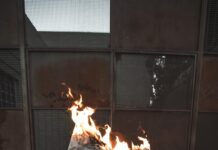
A look at over-militarized police, six months after Ferguson …
When Darren Wilson shot Michael Brown in Ferguson, Missouri on August 9, 2014, the country was propelled into a battle that pitted ordinary citizens against an over-militarized police force. Rather than handle the rising protests with diplomacy, Ferguson police erupted into a series of unprovoked?and increasingly violent?attacks on peaceful protestors.
The months’ long battle between predominantly African-American citizens in the Ferguson area and police created two stark realizations. The first was?that the plight of the oppressed and unheard citizens was reaching a boiling point. The second was?an over-whelming example of why the military should be the military and the police should be the police.
The rapid deployment of military weaponry against the citizens of Ferguson was brutal. We had seen some of this over-militarization of our police forces during the Occupy protests of 2011, but those now seem pale when?compared to the response in Ferguson.
In a stunning?graphic report,?the St. Louis Post-Dispatch has laid out a chronological timeline of the events that have occurred over the last six months in and around Ferguson. The report begins,
“The killing of an 18-year-old black teen by a white police officer on a street in Ferguson was the spark that ignited years of frustration, distrust and anger. Protests of the killing of Michael Brown, fueled by social media, continued for weeks. Days were filled with marches and meetings, nights devolved into confrontations with police. New issues emerged to be explored, debated. Fervor ebbed, then exploded anew when a second, and third police shooting occurred. Protests moved into Clayton, the Shaw neighborhood, St. Louis University, downtown. A night of arson and looting followed the announcement that a grand jury would not indict the police officer. Protests spread across the nation. Here, from the epicenter, is the story of Ferguson.”?
The biggest realization following the death of Michael Brown
The Post-Dispatch report uses a summary approach, with brief statements beneath poignant photographs, followed by a listing of reference articles that were written as the events were happening. In these various articles, the Post-Dispatch does a supreme job of reporting the events in as unbiased a way as possible.
This was a refreshing change from the reports on the nightly news and most mainstream news outlets, whose reports seemed based on the premise that the peaceful protestors deserved the treatment they received at the hands of out-of-control police officers. ‘Unruly protestors, looters, and rioters’ were blamed when the police applied too much fire-power and made decisions lacking any semblance of common sense in the deployment of tear gas, flash grenades, and Long Range Acoustic Devices (LRAD).
?“The focus on continuing protests here turned Thursday toward paramilitary tactics and equipment that critics ? even among some law enforcement leaders ? say have provoked violence from the crowds.”
When asked about the unprovoked attacks on protestors by police and the use of militarized weaponry, St. Louis County Police Chief Jon Belmar?stated,
?At the end of the day, we didn’t kill anyone because of our actions or seriously injure someone.?
Such a callous attitude to justify the use of weaponry designed for war evoked further cries of protest from citizens.

The equipment available to police in Ferguson …
The complete listing of the equipment available for use Ferguson was never released, however:
“According to federal data, various police agencies in St. Louis County received 12 5.56mm rifles and six .45-caliber pistols between Aug. 2, 2010, and Feb. 13, 2013. They also received 15 ?reflex? gun sights, four night vision devices and three night sights, as well as a $10,000 explosive ordnance robot, three helicopters, seven Humvees and three cargo trailers. One helicopter alone was originally worth $200,000.
State data obtained in 2012 show that St. Louis County police received at least two helicopters, computer equipment, two old SUVs and roughly 20 Kevlar helmets since 2007.”
The director of the CATO Institute Project on Criminal Justice, Tim Lynch, was quoted in one article discussing the over-militarization of local and state police forces:
?The downside is that we are starting to blur the civilian police mission with the military mission and when that happens, there are unnecessary, violent confrontations between the police and citizens such as we’re seeing in Ferguson.??
In another chilling article about the suburban backdrop of Ferguson,
“The scenes from Wednesday night prompted CNN legal analyst Jeffrey Toobin to say the police response in Ferguson made the place look like Belfast during the Northern Ireland bombings. And he noted that it’s the big cities that saw riots in the 1960s that have been more peaceful.”
The deployment of quasi-military force to quell peaceful protests in the after-math of the Brown shooting,?lends proof positive?that police forces in the United States have moved away from their previous mission of “To Serve and To Protect” and have become an adjunct arm of the United States military. In their application of the same tactics used overseas to quell upheaval in other nations, our police forces have?assumed the position of invader into our society of peaceful citizens wanting nothing more than to have a voice.
Police no longer seem to serve the citizens, but rather to serve some unseen dictatorial leader that seeks to quash freedom of speech and expression.





